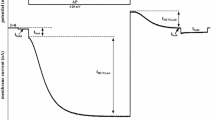Abstract
It is widely believed that HERG (human ether-a-go-go-related gene) encodes the major subunit of the cardiac ”rapid” delayed rectifier K channel. The aims of the present study were threefold: (1) to record directly the time course and voltage dependence of expressed HERG current in a mammalian cell line, during an imposed ventricular action potential (AP); (2) to compare this with native rapid delayed rectifier current (I Kr) elicited by applying an AP command to isolated guinea-pig ventricular myocytes; (3) to provide mechanistic information regarding the profile of HERG/I Kr during the AP. We used the AP clamp technique and conventional whole-cell patch-clamp recordings at 32–34°C. HERG was transiently expressed in Chinese hamster ovary (CHO) cells. There was an outward current in transfected CHO cells, which developed progressively during the AP plateau and slow repolarisation phase. The instantaneous current-voltage (I-V) relation for both leak-subtracted HERG current (n=10) and E-4031-sensitive current (n=6) during AP repolarisation was maximal between –30 mV and –40 mV. The conductance-voltage (G-V) relation was maximal at potentials between –60 and –75 mV. A similar voltage dependence for HERG current was observed during a descending ramp from +60 to –80 mV (n=5), but not during either an ascending ramp (n=5), or a reversed AP waveform (n=8). These data suggest that instantaneous HERG current during the AP does not depend on the instantaneous command voltage alone, but upon the previous voltages during the applied waveform. The time course of activation of HERG current at potentials near the AP plateau was rapid. Tail currents recorded on premature repolarisation at different time points in the AP showed directly that HERG also activates rapidly during the AP. The I-V profiles of fully activated HERG and of current during the AP were very similar. I Kr from guinea-pig ventricular myocytes was measured as E-4031-sensitive current during the AP clamp command. The current had a similar I-V and G-V profile to HERG current in CHO cells. These data indicate that HERG current and native I Kr are similar during an applied AP waveform. Activation of HERG is rapid during the AP. However, due to rapid inactivation relatively little current flows until the potential becomes less positive than 0 mV. The removal of inactivation then allows more current to flow, giving rise to the distinct instantaneous I-V profile during the AP. The correlation between the voltage dependence of HERG during the AP and the fully activated I-V relation indicates that the contribution of HERG/I Kr to AP repolarisation is more significantly determined by the open-channel I-V relation, than the precise activation time course of the current.
Similar content being viewed by others
Author information
Authors and Affiliations
Additional information
Received: 20 April 1998 / Received after revision: 8 July 1998 / Accepted: 13 July 1998
Rights and permissions
About this article
Cite this article
Hancox, J., Levi, A. & Witchel, H. Time course and voltage dependence of expressed HERG current compared with native ”rapid” delayed rectifier K current during the cardiac ventricular action potential. Pflügers Arch 436, 843–853 (1998). https://doi.org/10.1007/s004240050713
Issue Date:
DOI: https://doi.org/10.1007/s004240050713




